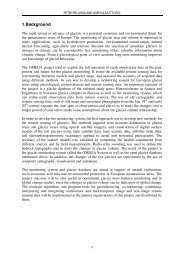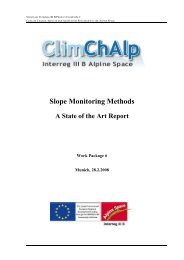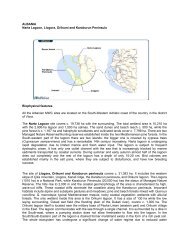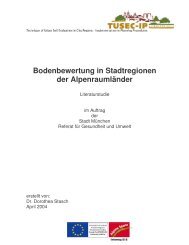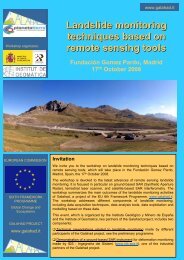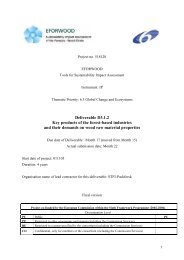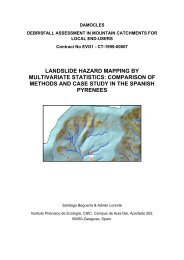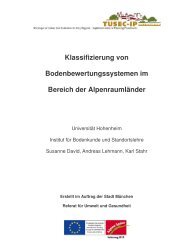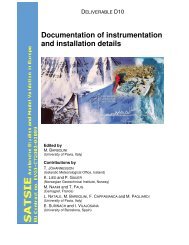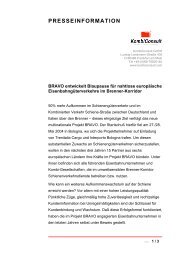Environmental Aspects of Sustainable Mobility - Transport Research ...
Environmental Aspects of Sustainable Mobility - Transport Research ...
Environmental Aspects of Sustainable Mobility - Transport Research ...
Create successful ePaper yourself
Turn your PDF publications into a flip-book with our unique Google optimized e-Paper software.
<strong>Research</strong> in Ireland into strategies for reducing diesel particulate emissions has estimatedthat in 2003 over 3000 tonnes <strong>of</strong> diesel particulate matter was emitted nationally by thefleet <strong>of</strong> some half a million diesel vehicles. The majority <strong>of</strong> these emissions occurred inurban areas and from light goods vehicles (responsible for 60% <strong>of</strong> all emissions). Oldervehicles with EURO1 or older engines were responsible for some 55% <strong>of</strong> these emissions.These issues suggest that emissions reduction strategies can be broadly grouped underthe categories <strong>of</strong> technological improvements to vehicles, use <strong>of</strong> cleaner fuels, betterinspection and maintenance programmes and better fleet management. Such researchhas also highlighted the danger <strong>of</strong> focusing particulate emission reduction strategies onreducing the total mass <strong>of</strong> emissions, without sufficient attention to the most damagingvolatile matter (EVALUATION OF OPTIONS FOR REDUCING IRISH DIESELPARTICULATE EMISSIONS).4.2.4 Policy implicationsPolicy implications stemming from this sub-theme relate primarily to the valuation <strong>of</strong>environmental impacts. <strong>Research</strong> findings confirm that the external costs <strong>of</strong> transportactivity in terms <strong>of</strong> environmental impact are high, and this lends support to EU policypriorities to reduce such costs through the development <strong>of</strong> improved technologies, relevantnew transport investments (including the TEN investments) and the internalisation <strong>of</strong>external costs to influence transport use and travel behaviour. Application <strong>of</strong>environmental impact assessment methodologies has demonstrated that whilst the TENinvestments will lead to an overall increase in passenger and freight travel demand, therewill also be a substantial shift to rail and a reduction in road congestion and improvementin road safety, all current policy priority areas. As a result, road vehicle emissions (otherthan CO 2 ) will fall. Whilst the TEN investments will reduce CO 2 emissions relative to a donothingscenario, there will be substantial increases in emissions from the air transportwhich will need to be addressed (COMMUTE, 2000).There are many uncertainties attached to the monetarisation <strong>of</strong> environmental impacts,such that prioritisation <strong>of</strong> action can be difficult. However, many policies <strong>of</strong>fer the benefit <strong>of</strong>reducing several different impacts at the same time. An integrated unified approach toreducing environmental impact, applying packages <strong>of</strong> relevant measures, may be the wayforward (RESEARCH OF ENVIRONMENTAL BURDEN OF TRANSPORTATION; D4NRP41 EXTERNAL COSTS AND INTERNALISATION – REGIONAL IMPACTS).The regional dimension is important in many parts <strong>of</strong> Europe, and it has been shown thatenvironmental impacts can vary significantly from region to region, even within individualEuropean countries. Policy formulation therefore needs to take regional impacts intoconsideration (POLICY AND PROJECT APPRAISAL AT REGIONAL LEVEL).Thematic <strong>Research</strong> Summary: “<strong>Environmental</strong> <strong>Aspects</strong> <strong>of</strong> <strong>Sustainable</strong> <strong>Mobility</strong>” Page: 27 <strong>of</strong> 48<strong>Transport</strong> <strong>Research</strong> Knowledge Centre




